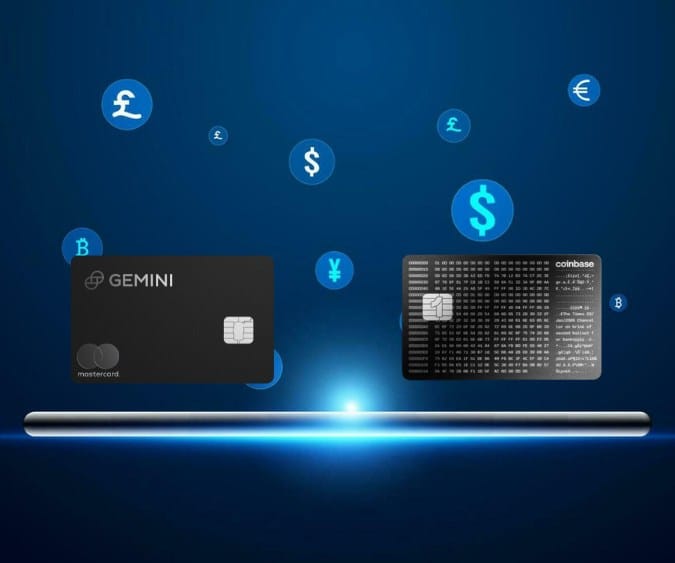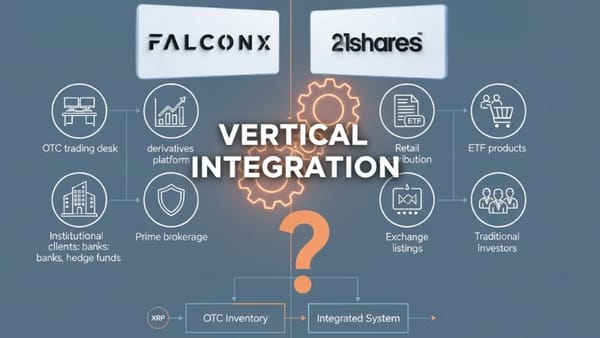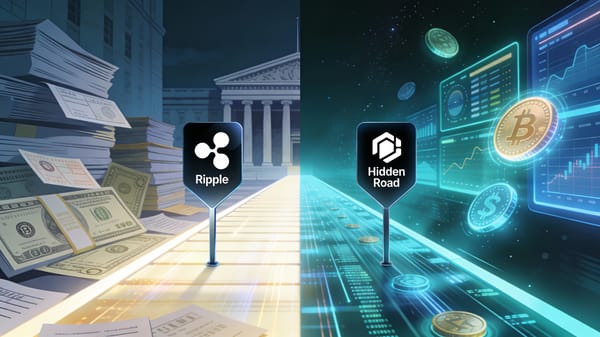Coinbase One Amex vs Gemini XRP Card: Payment Processing and Rewards Face-Off
Coinbase One Amex faces criticism for multi-day payment delays while Gemini XRP Card delivers instant rewards. Our head-to-head comparison reveals which crypto card actually delivers on blockchain's promise of speed.

Lead: As crypto credit cards compete for market dominance in 2025, two major players—Coinbase's One Amex Card and Gemini's XRP Card—offer vastly different user experiences. While both promise attractive crypto rewards, early user reports reveal that operational excellence may matter more than reward percentages. The Coinbase card faces criticism for multi-day payment delays, while Gemini's instant reward posting and seamless XRP integration showcase what blockchain-native thinking can achieve in traditional financial products.
JUST IN: 🇺🇸 Coinbase & American Express officially launch 'Coinbase One Card' in the US, offering up to 4% Bitcoin back on all purchases. pic.twitter.com/iTc6Wlsv6i
— Watcher.Guru (@WatcherGuru) October 22, 2025
The Tale of Two Card Infrastructures
The fundamental difference between these cards begins with their underlying architecture. The Coinbase One Card operates through a complex partnership: offered by Coinbase and Cardless, issued by First Electronic Bank, and running on the American Express Network. This multi-layered structure creates additional intermediaries in every transaction and payment cycle.
In contrast, the Gemini XRP Card, launched in partnership with Ripple in August 2025, is issued by WebBank on the Mastercard network. More importantly, it leverages direct integration with Gemini's exchange infrastructure and Ripple's RLUSD stablecoin, creating a streamlined pathway from purchase to reward delivery.
Payment Processing: The Critical Difference
User experience reports highlight the most significant operational divide between these cards. Coinbase One Amex cardholders report a frustrating payment processing issue: when making electronic payments to pay down balances, funds leave their bank accounts immediately but take multiple days—sometimes 3-5 business days—before the credit posts to their Coinbase card. During this gap, users cannot access their available credit despite having already paid.
The Gemini XRP Card operates on an entirely different timeline. According to user reviews, rewards post instantly to cardholders' Gemini accounts the moment transactions clear. One reviewer noted: "The instant rewards feature makes it feel satisfying. You see XRP drop into your Gemini account as soon as the payment clears. Compared to other crypto cards I've tried, that speed sets it apart."
This difference isn't merely about convenience—it reflects fundamentally different approaches to integrating crypto and traditional finance. Coinbase's card appears constrained by traditional ACH payment rails and multiple intermediary processing steps. Gemini's card, designed with blockchain efficiency principles from the ground up, delivers the instant settlement that crypto enthusiasts expect.
Rewards Structure Comparison
Coinbase One Amex Card
- Base Rate: 2% Bitcoin back on all purchases
- Maximum Rate: 4% Bitcoin back (requires $200,000+ in Coinbase holdings)
- Tiered Structure: 2.5% ($10,000-$49,999 holdings), 3% ($50,000-$199,999)
- Monthly Cap: Higher rates apply only to first $10,000 in monthly spending
- Annual Fee: Requires $49.99/year Coinbase One membership
- Reward Asset: Bitcoin only
Gemini XRP Card
- Gas/Transit: 4% XRP back (capped at $300/month, then 1%)
- Dining: 3% XRP back (no cap)
- Groceries: 2% XRP back (no cap)
- Other Purchases: 1% XRP back
- Bonus Merchants: Up to 10% back at select partners
- Annual Fee: $0
- Reward Assets: XRP, Bitcoin, Ethereum, or 50+ cryptocurrencies (user choice)
The XRP Advantage: Performance and Flexibility
According to Gemini's analysis, cardholders who earned XRP rewards and held them for just one year saw a 453% increase in USD value as of July 27, 2025. For context, cardholders who earned $73,700 in XRP rewards saw those holdings grow to over $407,000—demonstrating XRP's exceptional performance as a reward asset.
Beyond performance, the Gemini card offers unprecedented flexibility. Cardholders can switch between 50+ different cryptocurrencies for rewards at any time, allowing them to adapt their strategy based on market conditions, personal preferences, or tax planning. The card also integrates seamlessly with Ripple's RLUSD stablecoin, enabling users to convert rewards to stable value without leaving the Gemini ecosystem—addressing volatility concerns while maintaining crypto exposure.
Network and Acceptance
The Coinbase One Card runs on the American Express network, which offers extensive merchant acceptance in the United States but more limited international coverage compared to Visa or Mastercard. The card includes standard Amex benefits like purchase protection and exclusive offers through Amex Experiences.
The Gemini XRP Card operates on the Mastercard World Elite network, providing near-universal acceptance globally. Cardholders receive Mastercard World Elite benefits including cell phone protection, roadside assistance, exclusive merchant discounts through partners like Instacart, Lyft, and Peacock Premium, plus Mastercard ID Theft Protection and Zero Liability.
Fee Structure Analysis
Coinbase One Amex:
- Requires $49.99/year Coinbase One membership (functions as indirect annual fee)
- No foreign transaction fees
- APR: 28.24% (variable)
- Card closure if membership lapses
Gemini XRP Card:
- $0 annual fee
- No foreign transaction fees
- No exchange fees for crypto rewards
- APR: 18.99%-34.99% (variable, credit-dependent)
- $200 welcome bonus (spend $3,000 in first 90 days)
Ripple Partnership: Strategic Significance
The Gemini-Ripple partnership announced in August 2025 represents more than just card branding—it's a strategic integration of blockchain payment infrastructure with consumer finance. Ripple CEO Brad Garlinghouse emphasized this vision: "Fifty-five million Americans own crypto and that number is only increasing as more people look for easier ways to access and use it in their daily lives. With Gemini, we're making everyday spending a chance to earn and connect with both XRP and RLUSD."
This partnership delivers tangible benefits beyond marketing. The integration with Ripple's technology stack enables the instant reward posting that distinguishes Gemini's card from competitors. Additionally, the XRPL (XRP Ledger) that powers XRP is designed specifically for fast, low-cost transactions—principles that extend to the cardholder experience.
The timing is also strategic. With Ripple's SEC case resolved in August 2025 and multiple XRP ETF applications pending, the regulatory environment for XRP-based products has significantly improved. Major financial institutions including abrdn, Braza Bank, Société Générale-Forge, and Guggenheim Treasury Services have adopted XRPL for payments and settlement, demonstrating institutional validation of the technology.
User Experience: Real-World Feedback
The Coinbase One Card launched applications in fall 2025, with early users reporting mixed experiences. While the metal card design featuring the Bitcoin Genesis Block receives praise, operational issues overshadow aesthetic appeal. Customer service representatives have reportedly acknowledged payment processing delays but offer no solutions, suggesting these are structural issues rather than temporary bugs.
Gemini XRP Card reviews consistently highlight positive operational experiences. Users appreciate the instant reward visibility, the ability to track rewards in the Gemini app with real-time USD valuations, and the seamless switching between different cryptocurrencies. The physical card's security-first design—with card numbers only accessible through the app—receives particular praise.
Market Context: The Crypto Card Evolution
The crypto credit card market has evolved significantly since the 2022-2023 market downturn. Many cards disappeared or were downgraded. As of 2025, the Gemini Credit Card is one of the few true crypto credit cards still operating in the U.S. that doesn't require staking tokens or settling for minimal rewards.
The Coinbase entry represents a major exchange's attempt to compete in this space, but early execution challenges reveal that brand recognition alone doesn't guarantee operational excellence. Meanwhile, Gemini has expanded its crypto card lineup beyond XRP to include a Solana edition with auto-staking features launched October 2025, demonstrating continued innovation and commitment to this product category.
For XRP Holders and the XRP Army
The Gemini XRP Card offers particular appeal to XRP holders and community members—the so-called "XRP Army." Tyler Winklevoss, Gemini CEO, explicitly designed this card to give "customers and the XRP Army new ways to earn XRP and express their passion, loyalty, and excitement."
The card enables XRP accumulation through everyday spending without manual purchases, effectively dollar-cost averaging into XRP automatically. With XRPL's growing institutional adoption and XRP's utility in cross-border payments through Ripple's On-Demand Liquidity (ODL) network—now used by over 300 financial institutions—cardholders participate in an ecosystem with real-world utility beyond speculation.
The integration with RLUSD stablecoin provides additional flexibility. Cardholders can earn XRP for potential appreciation while having easy access to stable value, addressing one of the primary concerns about crypto rewards: volatility.
Which Card Should You Choose?
Choose Coinbase One Amex if you:
- Already hold substantial assets ($50,000+) on Coinbase
- Are committed Bitcoin maximalists who only want BTC rewards
- Value the Coinbase One membership benefits beyond the card
- Can tolerate payment processing delays
- Prefer American Express network benefits and acceptance
- Plan to spend over $10,000 monthly to maximize higher reward tiers
Choose Gemini XRP Card if you:
- Want instant reward posting and immediate access to crypto
- Prefer flexible rewards (50+ cryptocurrency options)
- Don't want to pay annual fees or membership requirements
- Believe in XRP's long-term potential and utility
- Value category-based rewards (4% on gas, 3% on dining, 2% on groceries)
- Want integration with RLUSD stablecoin for volatility management
- Prefer near-universal Mastercard acceptance
- Appreciate Ripple's institutional payment infrastructure
The Bigger Picture: Blockchain Payment Infrastructure
The operational differences between these cards illustrate a broader industry lesson: successfully integrating crypto into traditional finance requires more than adding cryptocurrency rewards to existing infrastructure. It demands rethinking payment processing from the ground up.
Coinbase's multi-day payment delays demonstrate what happens when blockchain-native companies try to operate within traditional banking constraints. The multiple intermediaries—Coinbase, Cardless, First Electronic Bank, American Express—each add processing time and complexity.
Gemini's instant posting shows the advantage of building products with blockchain efficiency principles at their core. By partnering with Ripple, a company whose entire value proposition is fast, efficient payments, Gemini delivers the speed and simplicity that crypto users expect. This isn't just better user experience—it's proof that blockchain-native thinking can enhance traditional financial products.
For Ripple and XRP specifically, this partnership validates the network's utility beyond speculative trading. The XRPL's design—prioritizing speed and low transaction costs—translates directly into superior cardholder experience. As more institutions adopt XRPL for payments (currently over 300 financial institutions use Ripple's ODL), products like the Gemini XRP Card demonstrate how blockchain infrastructure can power better consumer financial products.
Conclusion: Operational Excellence Matters
While both cards offer attractive reward percentages on paper, real-world performance tells a different story. The Coinbase One Amex card's payment processing delays undermine its value proposition, frustrating users who expect the reliability associated with the American Express brand. The required membership fee, limited to Bitcoin rewards, and complex tiered structure further constrain its appeal.
The Gemini XRP Card delivers on crypto's core promise: faster, more efficient financial transactions. Instant reward posting, flexible cryptocurrency options, zero annual fees, and seamless RLUSD integration create a compelling product that works as well as it sounds. The Ripple partnership brings both technological advantages and strategic positioning as XRP gains institutional adoption and regulatory clarity.
For crypto enthusiasts in 2025, the choice is clear: operational excellence, user experience, and flexibility matter more than brand names and marketing promises. The Gemini XRP Card represents what crypto credit cards should be—fast, transparent, flexible, and built on blockchain infrastructure that actually delivers value rather than just talking about it.
DISCLAIMER: This newsletter is for informational purposes only and does not constitute investment advice, advertising, or a recommendation to buy, sell, or hold any securities. This content is not sponsored by or affiliated with any of the mentioned entities. Investments in cryptocurrencies or other financial assets carry significant risks, including the potential for total loss, extreme volatility, and regulatory uncertainty. Past performance is not indicative of future results. Always consult a qualified financial professional and conduct thorough research before making any investment decisions.
Sources
- Coinbase One Card Official Page
- Gemini XRP Card Official Page
- American Express - Coinbase Partnership Announcement
- PYMNTS - Gemini and Ripple XRP Card Launch
- Gemini Official Blog - XRP Card and RLUSD Integration
- CoinCodex - Gemini XRP Card Review
- CNBC Select - Gemini Credit Card Analysis
- CCN - XRP Card Performance Analysis
- CoinCodex - Coinbase One Card Review
- CoinDesk - Gemini Solana Card Launch
- OneSafe - XRP Card Impact Analysis



